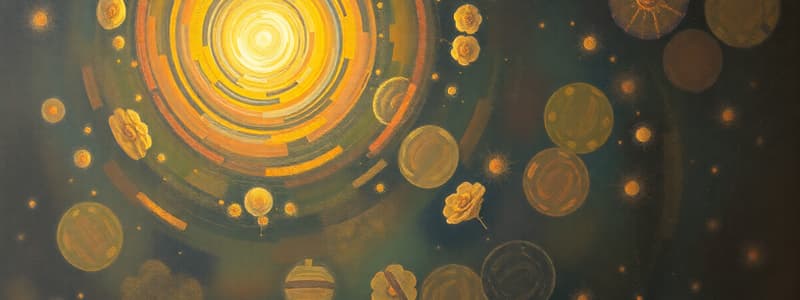Podcast
Questions and Answers
What determines the chemical element of an atom?
What determines the chemical element of an atom?
- The number of protons (correct)
- The number of neutrons
- The arrangement of shells
- The number of electrons
Which shell has the highest carrying capacity for electrons according to the arrangement provided?
Which shell has the highest carrying capacity for electrons according to the arrangement provided?
- N shell (correct)
- L shell
- K shell
- O shell
What is true about isotopes?
What is true about isotopes?
- They have the same number of protons but different number of electrons.
- They have the same number of protons but different number of neutrons. (correct)
- They are always electrically charged.
- They have different numbers of protons.
What is the maximum number of electrons that can occupy the L shell?
What is the maximum number of electrons that can occupy the L shell?
What happens to the total number of electrons in an atom when it is in its normal state?
What happens to the total number of electrons in an atom when it is in its normal state?
What are the two main parts of an atom?
What are the two main parts of an atom?
What charge do protons have?
What charge do protons have?
Which force pulls electrons toward the nucleus?
Which force pulls electrons toward the nucleus?
Which statement is true regarding atomic mass?
Which statement is true regarding atomic mass?
What is the overall charge of an atom in its natural state?
What is the overall charge of an atom in its natural state?
What role do centrifugal forces play in an atom?
What role do centrifugal forces play in an atom?
Which orbiting electrons experience a greater electrostatic force?
Which orbiting electrons experience a greater electrostatic force?
Neutrons are characterized by which property?
Neutrons are characterized by which property?
What is the primary focus of physics?
What is the primary focus of physics?
Which four substances did early Greek scientists believe composed all matter?
Which four substances did early Greek scientists believe composed all matter?
What does the term 'atom' mean in Greek?
What does the term 'atom' mean in Greek?
According to John Dalton, how did elements behave?
According to John Dalton, how did elements behave?
What was J.J. Thomson's contribution to atomic theory?
What was J.J. Thomson's contribution to atomic theory?
How did Rutherford describe the structure of the atom?
How did Rutherford describe the structure of the atom?
In Bohr's atomic model, how do electrons behave?
In Bohr's atomic model, how do electrons behave?
What was the common belief about atomic structure during the late 1800s?
What was the common belief about atomic structure during the late 1800s?
What is the formula to calculate the number of neutrons in an atom?
What is the formula to calculate the number of neutrons in an atom?
How many maximum electrons can the third shell (M-shell) hold?
How many maximum electrons can the third shell (M-shell) hold?
Which statement about electron binding energy is correct?
Which statement about electron binding energy is correct?
What determines the frequency of electromagnetic radiation?
What determines the frequency of electromagnetic radiation?
Which of the following best describes electromagnetic radiation?
Which of the following best describes electromagnetic radiation?
What is the relationship between wavelength, frequency, and the speed of light?
What is the relationship between wavelength, frequency, and the speed of light?
What happens when an electron moves from an outer shell to an inner shell?
What happens when an electron moves from an outer shell to an inner shell?
Which of the following statements is true regarding the nucleus of an atom?
Which of the following statements is true regarding the nucleus of an atom?
Flashcards
Definition of Physics
Definition of Physics
Physics studies the fundamental properties and movement of matter.
Atom (Greek)
Atom (Greek)
The smallest indivisible part of matter according to ancient Greek philosophers.
Dalton's Atomic Theory
Dalton's Atomic Theory
Elements are made of identical atoms with specific atomic masses, reacting the same way chemically.
Thomson's Atomic Model
Thomson's Atomic Model
Signup and view all the flashcards
Rutherford's Atomic Model
Rutherford's Atomic Model
Signup and view all the flashcards
Bohr's Atomic Model
Bohr's Atomic Model
Signup and view all the flashcards
Matter
Matter
Signup and view all the flashcards
Structure of Matter
Structure of Matter
Signup and view all the flashcards
Electron Shells
Electron Shells
Signup and view all the flashcards
Shell Codes (K, L, M, ...)
Shell Codes (K, L, M, ...)
Signup and view all the flashcards
Electron Binding Energy
Electron Binding Energy
Signup and view all the flashcards
Neutral Atom
Neutral Atom
Signup and view all the flashcards
Isotopes
Isotopes
Signup and view all the flashcards
Bohr atom
Bohr atom
Signup and view all the flashcards
Atomic Nucleus
Atomic Nucleus
Signup and view all the flashcards
Proton
Proton
Signup and view all the flashcards
Neutron
Neutron
Signup and view all the flashcards
Electron
Electron
Signup and view all the flashcards
Electrostatic force
Electrostatic force
Signup and view all the flashcards
Centrifugal force
Centrifugal force
Signup and view all the flashcards
Atomic Number (Z)
Atomic Number (Z)
Signup and view all the flashcards
Mass Number (A)
Mass Number (A)
Signup and view all the flashcards
Number of Neutrons (N)
Number of Neutrons (N)
Signup and view all the flashcards
Electromagnetic Radiation
Electromagnetic Radiation
Signup and view all the flashcards
Wavelength
Wavelength
Signup and view all the flashcards
Study Notes
Definition of Physics
- Physics deals with the fundamental properties and motion of matter.
- Matter is all physical substances around us that have mass and occupy space.
- The universe is composed of matter and energy.
History of the Atom (Greek Atom)
- Ancient Greek scientists believed matter was composed of four elements: earth, water, air, and fire.
- These elements combined in various proportions and were modified by wet, dry, hot, and cold essences.
- The concept of "atom" meaning indivisible, was used to describe the smallest part of these elements.
- Each type of atom was represented by a specific symbol.
Dalton's Atom
- In 1808, John Dalton proposed a model based on experiments.
- Elements are classified according to integral values of atomic mass.
- An element consists of identical atoms that react chemically in the same way.
- For example, all oxygen atoms are alike.
Thomson's Atom
- In the late 1890s, J.J. Thomson discovered electrons as an integral part of atoms.
- He visualized the atom as a "plum pudding" model, where electrons (plums) are embedded within a positively charged mass (pudding).
- The number of electrons balances the positive charge, making the atom electrically neutral.
Rutherford's Atom
- Rutherford's model suggested an atom is mostly empty space with electrons orbiting a small, dense, positively charged nucleus.
Bohr's Atom
- In 1913, Niels Bohr refined Rutherford's model.
- Bohr's model likened the atom to a miniature solar system, with electrons revolving in prescribed orbits or energy levels.
- For simplicity, Bohr's model, while not perfectly accurate, represents the structure effectively.
- This model was later refined by quantum chromodynamics (QCD)
The Atom (Structure)
- Atoms have two main components: a nucleus and orbiting electrons.
- The nucleus contains protons and neutrons (called nucleons).
- Neutrons have no electrical charge, while protons carry a positive charge.
- Electrons have a negative charge.
- Electrons are arranged in energy levels or shells.
Atomic Particles
- Protons: Larger and heavier than electrons, have a positive charge (+), and are located in the nucleus.
- Neutrons: Large and heavy, similar to protons but have no electrical charge, found in the nucleus.
- Electrons: Tiny and light, carry a negative charge (-), orbit the nucleus in shells.
Electron Binding Energy
- Energy required to remove an electron from an atom.
- Inner-shell electrons have higher binding energy than outer-shell electrons.
- Energetic particles can knock out inner-shell electrons only if their energy equals or exceeds the electron binding energy.
Shells
- Each atomic shell has a principal quantum number, starting with 1 for the K-shell, 2 for the L-shell and so forth.
- Electrons in a given shell can have a certain maximum capacity, based on the 2n^2 rule.
- The electron distribution is: 2, 8, 18, 32, 21, 9, and 2 in successive shells.
Electromagnetic Radiation
- Electrons transitioning between energy shells emit electromagnetic radiation.
- This radiation is quantized (exists in discrete energy packets called photons).
- Electromagnetic radiation is a transverse wave, where the electric and magnetic fields vibrate perpendicular to the direction of the wave motion.
Atomic Properties
- Atoms are electrically neutral in normal state (number of electrons = number of protons).
- The atomic number corresponds to the number of protons.
- Isotopes have the same number of protons but different numbers of neutrons.
- The mass number is the sum of protons plus neutrons.
Summary of Atomic Structure
- Atoms have a dense, positively charged nucleus where most of the mass is concentrated.
- The atom is essentially empty space, occupied mostly by electrons orbiting the nucleus.
- Shells determine probable electron locations based on quantized energy levels.
Additional notes
- Diagrams and figures are important visual aids for understanding the concepts.
- Practice calculations related to atomic numbers, mass numbers, isotopes etc.
Studying That Suits You
Use AI to generate personalized quizzes and flashcards to suit your learning preferences.
Related Documents
Description
Explore the foundational concepts of physics, including the properties and motion of matter. Delve into the historical development of atomic theory from Ancient Greece to Dalton and Thomson's models. This quiz covers significant milestones in our understanding of the atomic structure.




